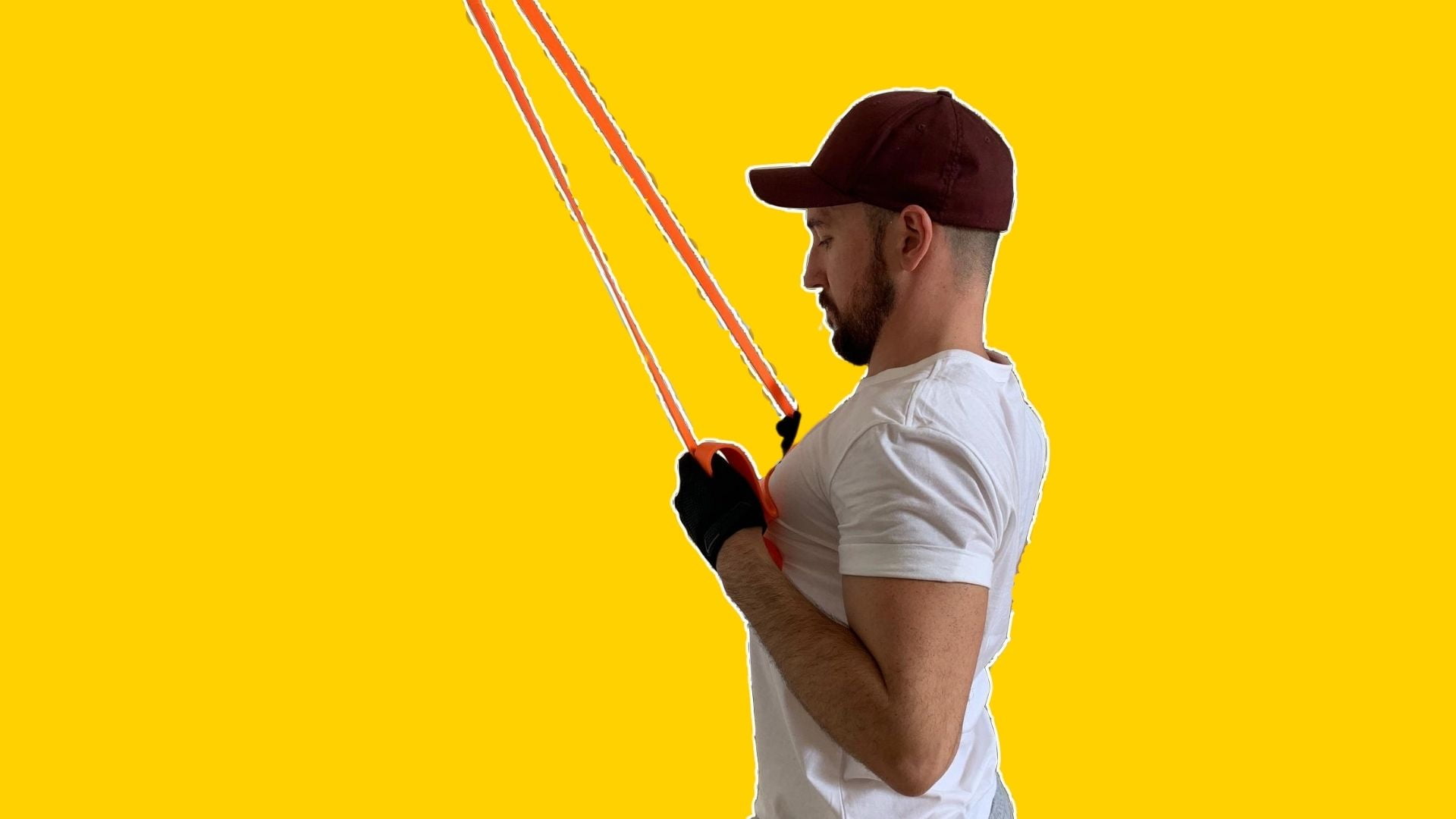
Banded Lat Pulldown: Benefits and How to Do It Correctly
What’s the most recent time you did your back muscles a workout? The pulldown exercise is perfect to build an athletic back. the pulldowns with a resistance band are a great way to begin.
This article will walk you through all you need to know to begin learning about banded lat pulldown. Alongside the traditional banded lat pulldown, this article will discuss various lat exercises using bands, too. Check it out!
What Is Banded Lat Pulldown?
The banded lat pulldown is among the most effective exercises to strengthen your back and improve your posture.
In addition, banded lat pulldown is adaptable and beneficial for those with all levels of fitness.
Banded Lat Pulldown: Working Muscles
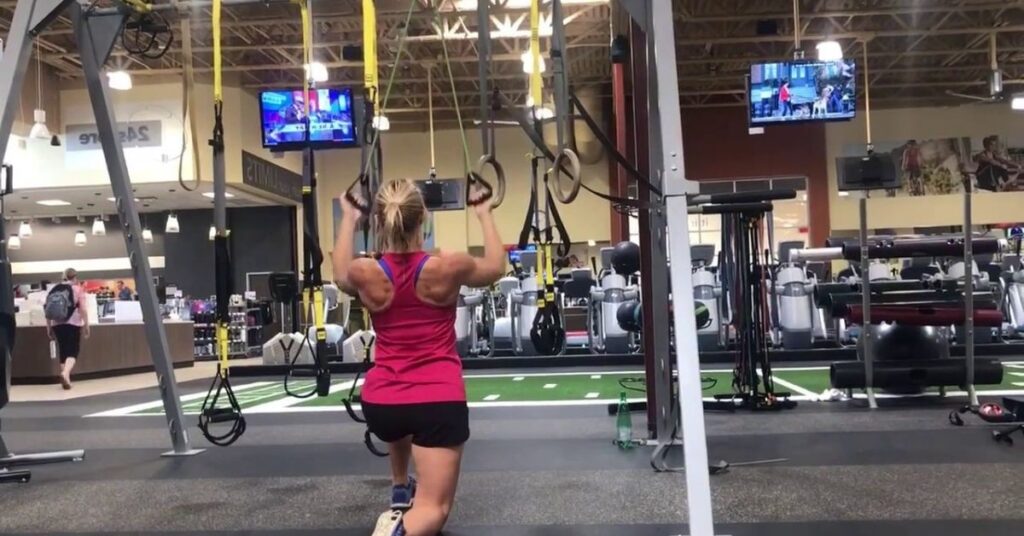
Primary Muscle Group
Based on the nature of the exercise, it’s not surprising that the pulldown of your lats banded is primarily focused on your lats. The origins of the exercise are in the mid-and lower back and mid-back, the muscles of the latissimus Dorsi is the biggest muscle in the back.
Your lats play an important part in the majority of “pulling” exercises, such as the pulldowns or pull-ups as well as various rowing workouts. They also provide essential support and stability for your spine.
Secondary Muscle Groups
The pulldown of the resistance band includes the biceps, abs, forearms, deltoids, and the upper back. While your lats will perform the bulk of the work to lower the band your forearms and biceps are also contracted.
Furthermore, your abs are activated to stabilize your midsection.
Banded Lat Pulldown: Benefits
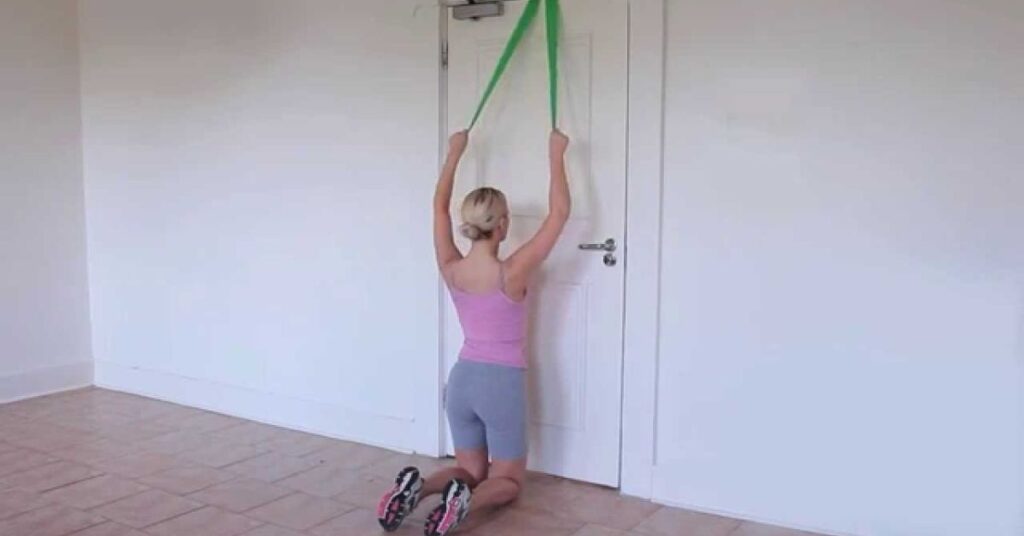
#1 Stronger And Bigger Lats
When you perform the banded pulldown, resistance will increase as you lower your weight. As compared to the conventional cable lat pulldown this banded lat pulldown targets the lats most in the bottom portion of every repetition. Simply put it means that you will have to push harder during the exercise.
In the end, you can increase the contracting of your lats which will help you build a stronger and stronger back. A well-built back is vital to improve your performance in sports as well as other compound lifts and other everyday routines.
#2 Posture Change
Banded lat pulldown is one of the best exercises you can do to improve your posture. A lot of time, sitting in workplace chairs or driving for long commutes can harm your posture. These actions can result in an unnatural shoulder posture which becomes habitual over time and can cause tension and pain in your back and shoulders.
Banded lat pulldown can be used in a way to improve posture and assist in activating the underemployed muscles in the back. If you regularly exercise and practice and practice, you’ll be standing straight and in good posture within a matter of minutes.
#3 Convenience
Banded lat pulldown could be better than other lat pulldown variations due to its convenience aspect. If you own the band that you can use to help you then you’ll likely be able to do this workout.
On the other hand gym memberships and cable, the equipment could be extremely expensive. Therefore, the banded lap pulldown is regarded as a more affordable, practical option for fitness-conscious individuals.
Banded Lat Pulldown: Instructions
Equipment
To perform this exercise, you’ll need the resistance band (with or without handles) as well as an elevated hanger, door frame, or any other solid object to hold the band.
Setup
- Attach your resistance band to an elevated hook or door frame. Then either kneel or sit in the dirt.
- If your band comes with handles, extend your arms to the side to grab the handles using your palms facing toward the front. If your band doesn’t have handles, you can grab it with both your hands facing upwards with the hands placed slightly more than your shoulder distance.
Action
- Brace your core, pull your shoulder blades back and back, then push the band until it is at the chest level.
- Pause briefly at the bottom, then squeeze your lats, then slowly return to your starting position.
- Maintain your tightness in your core, and repeat!
Recommendation
It is recommended to do 3-4 sets of 10 to 15 reps of the banded lat pulldown. As you become more comfortable with the method, you can choose to alter your rep and set ranges to test yourself.
Banded Lat Pulldown: Mistakes
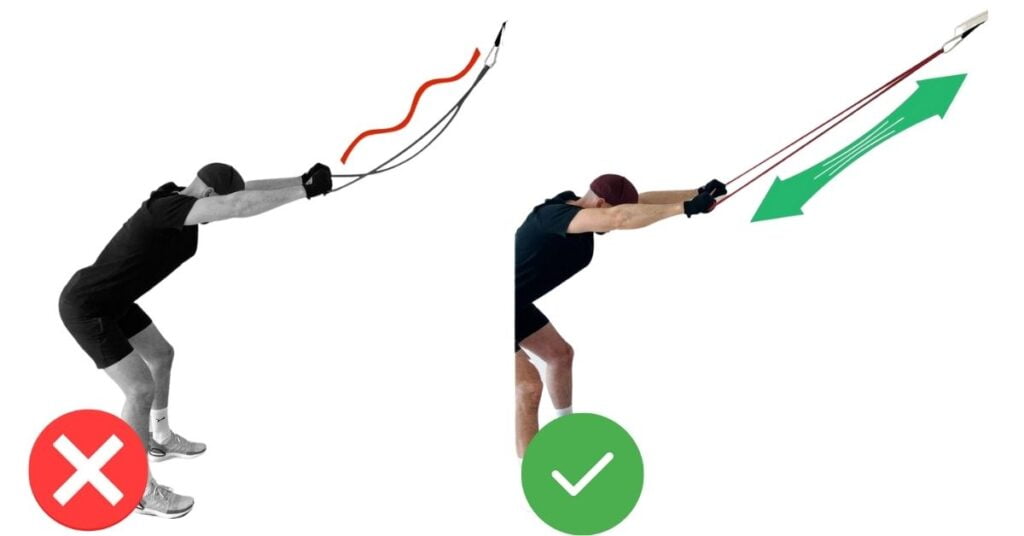
#1. Completing Partially Returned Payments
A lot of lifters will complete partial reps when performing banded lat pulldown. This is because the growing tension on the band makes it hard to complete each repetition correctly.
If you are unable to complete the full rep, you can choose the band that has less resistance or decrease the initial tension of the band. It’s better to complete only fewer reps that are perfect instead of doing more reps that have poor technique!
#2. Utilizing Your Arms Too Much
Another common error when doing pulldowns using a resistance band is to rely on your arms to pull your band downwards. In reality, the pulldown turns into an arm exercise that significantly reduces the strain on your back.
Instead, to try this, you can bring the band downwards using your elbows back and back while you squeeze the lats. This can also help increase the connection between your mind and muscles!
#3. Using Momentum To Delete
If lifters rely on the force of their bodies to pull the band downwards the band, they’re usually doing too much resistance. This is why they swing their body around to make up for the loss.
In actuality, it isn’t helping to build the strength of your back. If you’ve made this mistake Try reducing the resistance or decreasing the initial tension of the band. Make sure to keep your back firmly in place while banded lat pulldown to maximize the gains.
Banded Lat Pulldown: Variations
#1 Seated Resistance Band Lat Pulldowns
Seated banded lat pulldown are among the top exercises to increase muscle strength within your lats. Contrary to banded lat pulldown in the seated position focus on your lats, so you don’t exhaust your triceps and biceps.
- Make sure you secure your theraband to the door anchor.
- You should sit in a chair and maintain an upright posture, and your feet spread shoulder-width apart.
- Make sure that your feet are level with the ground.
- Take one end of the band with each hand.
- Make sure to bring each edge of the band a bit further away than shoulder-width apart.
- Make sure you squeeze your back and then attempt to get your elbows close to the sides of your ribcage.
- Moving your arms closer to make the movement more difficult.
#2 Supinated Lat Pulldowns
The supinated grip or the reverse grip to pull down your lats can aid in strengthening not just the lats, but also the shoulders, biceps, and forearms too.
The bands you are using to resist the elements should be secured with handles to the frame of your door as well as your door anchor.
Place your feet shoulder-width apart, in front of the door.
Grab your handles with both hands, with palms facing upwards.
Get towards the exit, while holding both bands. Make sure that your bands aren’t loose or have any sort of resistance.
Kneel at the knee.
Relax your waist slightly to ensure that your chest is in the direction of the front door and that your back is straight and not rounded.
You can pull your elbow forward till your elbows rest to your sides.
Remain to the point that your arms and shoulders are fully extended.
#3 Single Arm Pulldown
Single-arm pulldowns strengthen your shoulder, your lats traps, and the rhomboids. Single-arm pulldowns are ideal for those who believe they have lats that are asymmetrical.
Attach a loop band to the surface that is elevated.
Begin by looping your hand through the band before grabbing the band.
Your hands should be directed toward you.
Now, kneel down using the leg to that side you’re using.
You should squeeze your glutes and squeeze your core to tighten them.
Use your arms (that must have been fully stretched) and, in an upward straight motion, extend your elbow towards your side.
Release slowly, and repeat the process on the opposite side.
#4 Narrow Grip Pulldowns
Narrow grip pulldowns are an excellent banded lat pulldown for those who need to perform lat pulldowns in your home. The narrow grip utilizes your lats and also your shoulders, biceps lower back, and abs.
Connect your bands of resistance using handles to an anchor for your door.
Hold the handles with your palms pointing toward one another.
On both legs, kneel or lay on the floor.
Stretch your lower back, then make sure you tighten your core.
Bring the bands back to the point that they’re in your chest’s upper portion while your arms are to your sides.
#5 Wide Grip Pulldowns with Resistance Bands
Wide grip pulldowns are great for working every major muscle in the back. Be sure to keep your core tight, your grip loose, your back neutral and your neck relaxed to prevent injury or strain. It is also crucial to not apply more force than you can manage. Start with a lightweight.
The bands you are using to resist will be secured with handles that attach to the frame of your doors, anchors for the door, or an elevated hook.
Grab the handles with your palms facing downwards.
You can kneel on one leg while holding onto the handles.
Stretch your arms so your brand has a pull towards it, and keep your spine in a neutral position.
While your arms are facing upwards towards the anchor for the door or the top on the frame of the door, you can pull your elbows downwards.
Try pulling your elbows toward your sides.
Return to the original point slowly and allow your arms to expand and straighten completely.
#6 Neutral Grip Pulldowns
Neutral grip pulldowns focus on the muscles of your latissimus dorsi. However, your back also gets involved because of the tight grip used.
Begin in the process of attaching resistance bands using handles to the door anchor.
Take your grips with your palms facing towards.
You can sit on the ground while using the handles.
Arms fully extended.
Inhale, and then push the handles downwards until your hands are above your chest.
Inhale and then return your arms to their starting position.
#7 Loop Band Lat Pulldowns
The loop-band pulldown exercise is ideal for people who are only using loop bands. It is the ideal pulldown for lats to strengthen your lats without the hassle that the bands provide.
Utilizing a loop band put the band on your wrists.
Reach your arms over your head and hold them with enough force to ensure that the band stays at your wrists.
Take your arms and stretch them out, trying to get your elbows back to your sides.
Make sure you move your head forward slightly and then bring the band behind you instead of directly in front.
Return your arms to an extended position, while maintaining resistance, so that the band remains around your wrists.
Banded Lat Pulldown: Alternatives
If you’ve enjoyed the banded lat pulldown then check out these alternatives exercises for the back to boost your upper body strength:
#1 Straight Arm Dumbbell Pullover
Relax on your back while keeping your knees bent with your feet on the floor. Grab a dumbbell using an overhand grip, and lift your arms straight over your chest.
Slowly return your arms until the dumbbells reach the floor. Next, you squeeze your lats until they return to the original position. Repeat!
#2 Barbell Pendlay Row
Install a barbell onto the ground, with a light to medium weight. Take a stand position with your feet shoulder-width apart. Move forward until the barbell is in the middle part of your feet.
Make sure you tie your waist at the waist, as you bend your knees in such a way the back of your body is equal to the floor. Take the bar in an overhand grip using your hands more than shoulder distance.
With your elbows in a slightly tucked position to your core, you should brace your back and contract your lats as you push your elbows upwards and down, pulling the barbell toward the chest’s bottom.
Make sure you squeeze your lats to the top, then stop for a few seconds, then slowly lower the barbell to the floor, in the starting position. Stay tight in your core and then back, repeat!
#3 1-Arm Underhand Row
To start take a kettlebell and hold it in one hand, and hinge it around your mid-section until the back of your body is equal to the ground. While your palm is facing the back and your arms straight, you should keep your body straight as you stretch your lat to pull the kettlebell back along an angle that is slightly distancing from your body.
Stop for a second at the top, then slowly return to your beginning position. Repeat!
How Many Lat Pulldowns Should I Make?
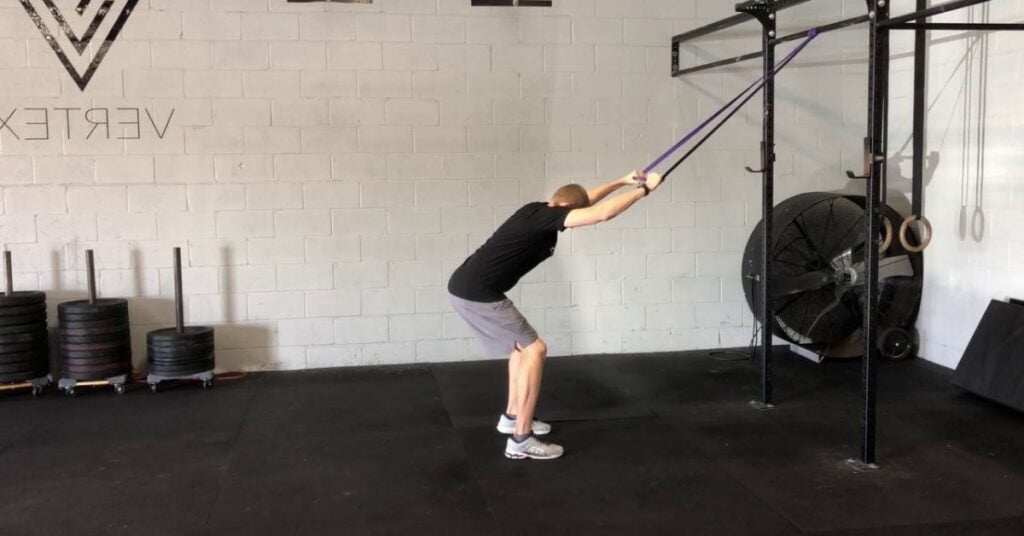
If you’re a beginner practicing three sets of eight to 10 reps twice per week, on Tuesday and Thursday (or similar) is a great way to see progress in your back as time passes.
It is crucial to concentrate on your posture and get the proper movement pattern for a beginner.
Based on your objectives, and if you’re an intermediate lifter, performing 3 to 4 sets of 8-10 reps every day each week will allow you to improve with time. As you progress through your training you will have reached the point where the “newbie progress” will have come to an end.
Most likely, you’ll perform fewer repetitions, but with more weight to create an increasing overload.
Whatever level of training you’re in, you must always ensure that you warm up correctly and concentrate on the exercise you’re doing. If you’re looking to stay safe from injury while performing lat pulldowns, make sure you don’t swing your body, and ensure that you do the exercise in a steady and controlled manner.
Last Words
In the last, here are some most important things to keep in mind:
If done correctly when done correctly, pulldowns with a resistance band help your lat muscles, which are the most powerful in your back.
What’s better, lat pull-downs or pull-ups? Lat pulldowns are ideal for those who are new and less difficult than pulldowns. They will help you develop the strength needed to do pull-ups in the gym.
Pulldowns can help build a stronger back V-tapering to improve your posture and ease back discomfort.
You can utilize various resistance bands to make at-home set-ups.
If you’ve not tried resistance band pulldowns, it’s the perfect time to test these. Your back will be awed by these!











